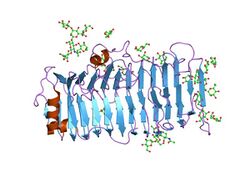Biology:Glycoside hydrolase family 28
| Glycosyl hydrolases family 28 | |||||||||
|---|---|---|---|---|---|---|---|---|---|
 rhamnogalacturonase a from aspergillus aculeatus | |||||||||
| Identifiers | |||||||||
| Symbol | Glyco_hydro_28 | ||||||||
| Pfam | PF00295 | ||||||||
| Pfam clan | CL0268 | ||||||||
| InterPro | IPR000743 | ||||||||
| PROSITE | PDOC00415 | ||||||||
| SCOP2 | 1rmg / SCOPe / SUPFAM | ||||||||
| CAZy | GH28 | ||||||||
| Membranome | 73 | ||||||||
| |||||||||
In molecular biology, glycoside hydrolase family 28 is a family of glycoside hydrolases EC 3.2.1., which are a widespread group of enzymes that hydrolyse the glycosidic bond between two or more carbohydrates, or between a carbohydrate and a non-carbohydrate moiety. A classification system for glycoside hydrolases, based on sequence similarity, has led to the definition of >100 different families.[1][2][3] This classification is available on the CAZy web site,[4][5] and also discussed at CAZypedia, an online encyclopedia of carbohydrate active enzymes.[6][7]
Glycoside hydrolase family 28 CAZY GH_28 comprises enzymes with several known activities; polygalacturonase (EC 3.2.1.15); exo-polygalacturonase (EC 3.2.1.67); exo-polygalacturonase (EC 3.2.1.82); rhamnogalacturonase (EC not defined).
Polygalacturonase (PG) (pectinase)[8][9] catalyzes the random hydrolysis of 1,4-alpha-D-galactosiduronic linkages in pectate and other galacturonans. In fruit, polygalacturonase plays an important role in cell wall metabolism during ripening. In plant bacterial pathogens such as Erwinia carotovora or Ralstonia solanacearum (Pseudomonas solanacearum) and fungal pathogens such as Aspergillus niger, polygalacturonase is involved in maceration and soft-rotting of plant tissue. Exo-poly-alpha-D-galacturonosidase (EC 3.2.1.82) (exoPG)[10] hydrolyzes peptic acid from the non-reducing end, releasing digalacturonate. PG and exoPG share a few regions of sequence similarity, and belong to family 28 of the glycosyl hydrolases.
References
- ↑ "Conserved catalytic machinery and the prediction of a common fold for several families of glycosyl hydrolases". Proceedings of the National Academy of Sciences of the United States of America 92 (15): 7090–4. July 1995. doi:10.1073/pnas.92.15.7090. PMID 7624375. Bibcode: 1995PNAS...92.7090H.
- ↑ "Structures and mechanisms of glycosyl hydrolases". Structure 3 (9): 853–9. September 1995. doi:10.1016/S0969-2126(01)00220-9. PMID 8535779.
- ↑ "Updating the sequence-based classification of glycosyl hydrolases". The Biochemical Journal 316 (Pt 2): 695–6. June 1996. doi:10.1042/bj3160695. PMID 8687420.
- ↑ "Home" (in en). http://www.cazy.org/.
- ↑ "The carbohydrate-active enzymes database (CAZy) in 2013". Nucleic Acids Research 42 (Database issue): D490-5. January 2014. doi:10.1093/nar/gkt1178. PMID 24270786.
- ↑ "Glycoside Hydrolase Family 28" (in en). http://www.cazypedia.org/index.php/Glycoside_Hydrolase_Family_28.
- ↑ CAZypedia Consortium (December 2018). "Ten years of CAZypedia: a living encyclopedia of carbohydrate-active enzymes". Glycobiology 28 (1): 3–8. doi:10.1093/glycob/cwx089. PMID 29040563. https://hal.archives-ouvertes.fr/hal-01886461/file/Hehemann_2018_01.pdf.
- ↑ "Cloning and DNA sequence analysis of a polygalacturonase cDNA from Aspergillus niger RH5344". Biochimica et Biophysica Acta (BBA) - Gene Structure and Expression 1087 (1): 104–6. September 1990. doi:10.1016/0167-4781(90)90130-t. PMID 2400785.
- ↑ "DNA sequence analysis of pglA and mechanism of export of its polygalacturonase product from Pseudomonas solanacearum". Journal of Bacteriology 172 (7): 3879–87. July 1990. doi:10.1128/jb.172.7.3879-3887.1990. PMID 2193922.
- ↑ "Molecular cloning, nucleotide sequence, and marker exchange mutagenesis of the exo-poly-alpha-D-galacturonosidase-encoding pehX gene of Erwinia chrysanthemi EC16". Journal of Bacteriology 172 (9): 4988–95. September 1990. doi:10.1128/jb.172.9.4988-4995.1990. PMID 2168372.
 |

